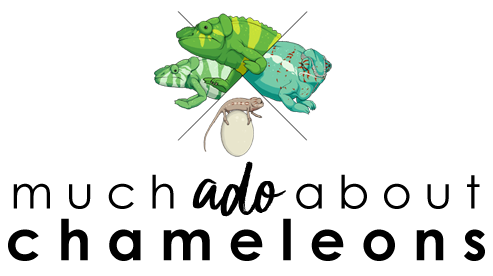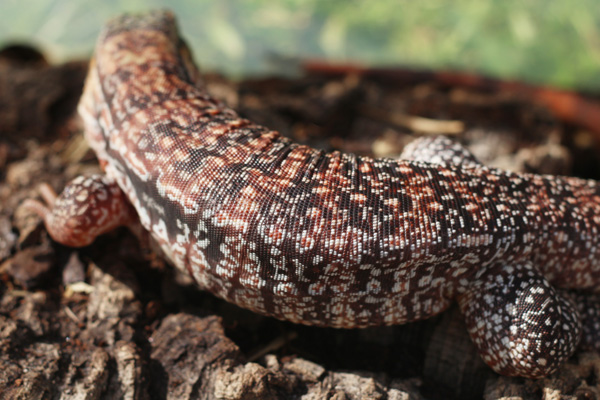Today, I'm going to address several common myths and misconceptions about chameleons and reptiles in general that I see repeated over and over in forums and among people I run into. I understand that people who do not keep reptiles as pets may not know, and that's fine, but I'm always amazed when reptile owners give out these myth answers as truth! So I will try to clear up the common ones here.
#1. "Superworms & mealworms will chew through your reptile's
stomach if you don't crush their head first."
This is completely untrue! There are reports that if you do not crush the worm's head before feeding it to your reptile, that it will chew its way through your pet's stomach to escape and kill it. There are theories that this old wive's tale must have started when a person discovered their dead lizard with worms chewing through it, and presumed that the worms had caused the death but it's much more likely that the lizard died first and the loose worms in the cage saw a chance to eat.
Whatever the source, it's a myth that has spread like wildfire from one new keeper to another. And has probably lead untold numbers of people to sit there with tweezers and crush the heads of their worms before feeding. This is not necessary!
 |
| Superworms (Zophobas morio) |
Mary Roach's Gulp: Adventures on the Alimentary Canal even dedicated a chapter of her book on the digestive system to talking about superworms/mealworms and this persistent myth. She followed physiological ecologist, Richard Tracy, Walt Mandeville, the university veterinarian, and a grad student as they fed worms to a bullfrog and watched what happened with an endoscope. They chose a frog because frogs do not chew their food before swallowing, therefore anything they ingest remains alive in their gut for a short time. The result? Nothing happened. The worms are lulled into stillness within the stomach (what they termed the "blanket effect" and then slowly died.
They then repeated the experiment with a dead stomach (no contractions and no stomach acid) the worms still did not chew through to freedom. They were lulled by the blanket effect and were dead in the stomach by morning.
So in case this wasn't enough to quell your fears, remember why they chose the frog for the experiment - because it doesn't chew. Your chameleon, bearded dragon, or gecko (and all other lizards) do chew their food before swallowing. Which means that the worm, if not instantly dead, is mortally crippled by the chewing and stands no chance to survive.
So feed those mealworms and superworms without fear - they will not exact their revenge!
#2. "Superworms & Mealworms cause impaction and should be avoided."
I don't know why these worms get such a bad reputation! There is another myth (less popular, thankfully) that you shouldn't feed mealworms and superworms because they cause impaction (a blockage of the digestive tract) because of their hard shells. This is also not true. The biggest cause of impaction in reptiles is dehydration - if you are not well hydrated there isn't enough water to keep everything lubricated properly and it becomes easier for food or foreign objects to become lodged in the gut. But when talking about a healthy, well-cared for reptile feeding these worms is not a health risk. In fact, all reptiles benefit from some roughage in their diet (just like we do) and benefit from eating insects with tougher exoskeletons as part of a varied diet.
They don't make a great staple feeder due to their nutritional value, however. They contain a lot of chitin and fat, so they should be reserved as an occasional feeder.
#3. "Chameleon females must be mated or they will die from egg-binding."
Absolutely, completely untrue! As we know, female chameleons of egg-laying species will produce infertile (or fertile, if mated) eggs (or duds) regularly starting at about 6-7 months of age. This myth states that if a young female is not mated before she lays those first infertile eggs that she will die from egg-laying complications or egg-binding. I do not know where this myth started but it's completely false.
A female chameleon should not be mated until she herself is full grown, at around a year of age. But they will start to produce eggs naturally much sooner than that, so people wonder why not mate them anyway? The reason is that fertile eggs take a lot more energy to produce. They require a lot more calcium and other materials that get taken from a female who is still growing herself. It is fine to let your female grow up without being mated.
And egg-binding issues are avoided the majority of the time by providing a suitable place to lay the eggs. So always have a proper laying bin in the cage from 6 months of age onward, just in case.
#4. "Reptiles will only grow to the size of their cage."
This myth is horrific, and I wish no one still believed this. Thousands of pets annually die from or live in completely inadequate enclosures because of this myth. Animals are not like bonsai trees, you cannot train them to stay small.
When I worked part-time at a pet store between classes I would sell dozens of aquatic turtles daily. Many of these people believed in this myth, and had to be told that their turtle would continue to grow regardless and that their tiny fish bowl at home would definitely NOT be sufficient. Most people were willing to learn and would get a much bigger aquarium for their turtle, and those who weren't were not sold a turtle at all. But I was so surprised that this myth still survives.
So regardless of whether you have a chameleon, a snake, or a turtle, they will reach the maximum adult size dictated by biology and evolution - not the size of their cage. So all reptiles should be provided with at least the minimum cage size required, and should be given something bigger still if possible.
#5. "Reptiles get lonely and need/like cage-friends."
With the exception of very few communal species, this is not true either. All the time we'd have people come into the store and want to buy a companion animal for their pet, whether it was a bearded dragon or a snake. But the truth is that reptiles have extremely poor social skills, they really don't have a developed social area of the brain. Therefore most of them are solitary - they don't feel loneliness, they don't long for a friend, they just want someone to mate with when the time is right and then to be left alone again. So what often happens with multiple reptiles sharing a cage is that one begins to bully the other over food and the best basking spots, or one becomes stressed and declines in health. So don't worry, your pet reptile is probably completely content alone in his cage.
However, reptiles do get bored like any other animal. So it is a good idea to figure out ways to enrich their daily lives, so that they are capable of exercising their mind and their body. Letting them hunt their own food is a great start, but providing environmental stimuli will perk them up. Giving a bearded dragon a place to dig in the dirt will bring out their instinct to burrow. Providing a snake with different branches and logs and mixing up their placement will keep them exploring. It's not hard to give them something to keep them entertained, but it doesn't have to be another animal.
#6. "Chameleons can change to match their [unnatural] background."
I still hear this myth and it makes me laugh! People still imagine that if I place my blue chameleon on my red striped shirt that he'll turn red and white to match it. This is not true! Their colors are dictated by mood and temperature, not environment.
All chameleons are born with a pattern and color unique to them or their species, and can only alter that pattern or color within a specific range. A green Jackson's chameleon, for example, will never turn purple. He will get bright, lime green with hints of blue to impress a lady or a rival or go all the way to black under extreme stress or cold. Even my bright blue panther chameleon cannot turn purple or yellow. He will either brighten up to a light blue or darken down all the way to grey blue, because that is his natural range. And even so, sometimes I cannot spot him in his cage! Because he will dull down the blue and among the shadows of his plants he completely disappears. He is still blue, but among the plants he blends right in. They can change to disappear among plants but definitely not to match unnatural surroundings!
So the first video, below, is completely false! Utterly false. This veiled chameleon is completely incapable of turning pink, blue, or orange to match the glasses.
Where as in the next video, by my friends at Chamelot Chameleons, this panther chameleon shows you a realistic example of a chameleon changing colors due to mood. In this case he has done what we call as "fired up."
#7. "Colloidal Silver can be given to pets as a cure-all or a preventative
against all diseases, so you don't have to go to the vet and buy medicine."
My followers will know that I am completely in favor of saving money if you can. And that there are things you can do at home to treat minor issues. But I would never recommend colloidal silver. Colloidal silver is just a suspension of silver powder in water, and is sold at health stores as an immune booster, an antibacterial, and a general cure-all and preventative. But the truth is that there are no medical journal articles that support any of these claims. Silver is not an essential element, nor does it play any role in the body. The FDA does not consider this product safe or effective, and major medical organizations also warn against taking this product, due to the various potential negative side-effects (such as accumulating in the body and staining the patient permanently silver, kidney damage, and seizures.)
So if there are so many warnings in its use for humans, why use it on your pets? Yet, people are recommending it more and more as a harmless thing to give to your pets to keep them healthy, despite it's cumulative (and potentially negative) effect in the body. And what's worse, people are starting to sell home-made colloidal silver products, whose purity and manufacturing process can't be verified.
I would never recommend that anyone choose to use this product instead of going to the vet. And I would be very worried about trusting someone who ardently recommends it.
#8. "If you have a D3 supplement you don't need a UVB bulb for a chameleon."
You guessed it, not true. Chameleons can regulate the amount of vitamin D3 they produce in their skin when exposed to UVB light, but they cannot control as well what happens with dietary D3 like from a calcium supplement. It will accumulate in the system and lead to severe health issues, which is why we only recommend D3 as a supplement, to use only a couple times a month to fill in any gaps (in case your UVB bulb is getting old, for example) but not to be relied on heavily.
#9. "Chameleons are impossible to keep successfully. They always die."
I always heard this one when I worked at the pet store. It seems like people think that chameleons are an impossible pet to keep alive so they just give up every trying to keep one. This isn't true! They are delicate and can be difficult, yes, but thousands of people keep them successfully so they certainly aren't impossible. I think people don't do their research, attempt to keep a chameleon in poor conditions (or buy a sick chameleon to begin with without realizing it), and when it dies they assume it's the fault of the chameleon. But with proper research and preparation there is no reason anyone is destined to fail.
More will be added as I come across more myths.














Thanks for this article. I was worried about superworms. Not now!
ReplyDeleteI read this article and fed two morios to my chameleon. The first one he loved. The second one bit him inside his mouth as he swallowed it - I saw him flinch and then try to rub his gular on a branch as if it hurt. Since then he has barely eaten, and won't even look at morios. Eating its way out of your cham's stomach might be a myth, but these superworms can really hurt your cham! I have squashed their mouth parts with forceps before offering to my boy again, but Rex is too wary to try another one!
ReplyDeletejustgot superworms and read your article about them being safe. for some reason my panther chemelon has stopped eating crickets. He is two and i raise my own crickets and food for crickets from a recipie i have been using for years just in case I bought Repashy Superload to change the taste of crickets Lol, I don"t know, I just want them to start eating crickets again. I tried roaches, didn't like, right now hornworms. How often hornworms? I want them to eat crickets again I even tried to not feed for 4 days, still no luck with crickets.
ReplyDeleteMy daughter and I just watched the first video you posted moments before I found your article, and it seemed... amazing, yet as a nurse I considered the likelihood of the anatomy and could NOT wrap my head around the possibility of anything organic hanging just to 'blend in' especially with unnatural colors. So... I began researching the reasonings behind their color changes. It didnt seem plausible for them to change based on 'want' it had to be for natural occurances such as finding a mate, or warning other males. I am so pleased you showed these videos. It truly helps individuals to learn that chameleons only change color for mating purposes, not for fun. Thank you.
ReplyDeleteThanks for helpful share! I really scare of supperworms -
ReplyDeleteReference: sell a home
Invest in Ripple on eToro the World’s Best Social Trading Network...
ReplyDeleteJoin 1,000,000's who have already found easier strategies for investing in Ripple.
Learn from profitable eToro traders or copy their orders automatically.